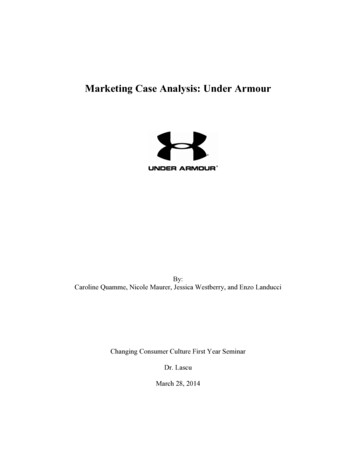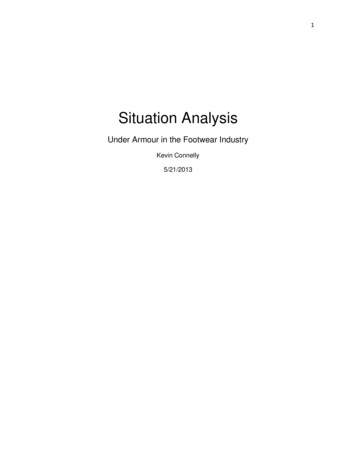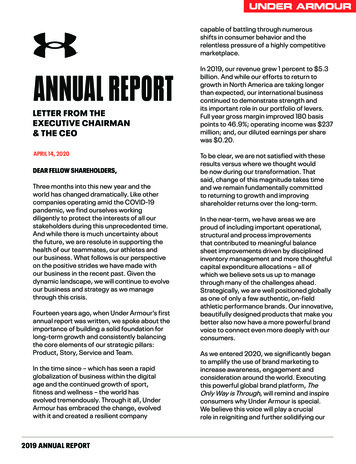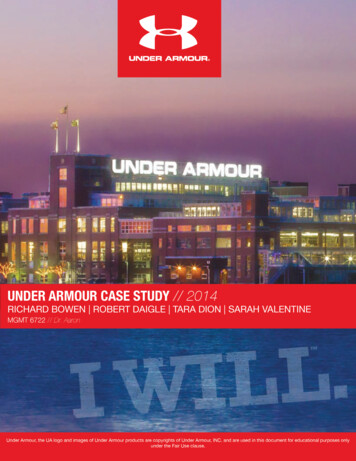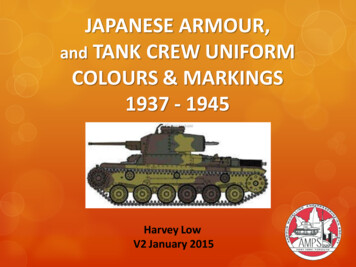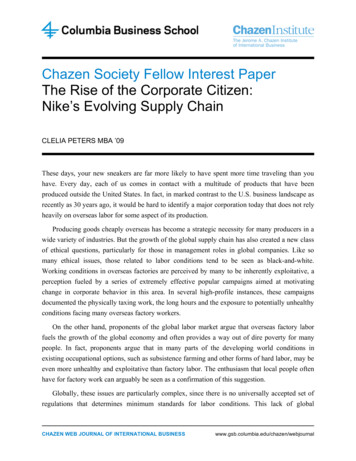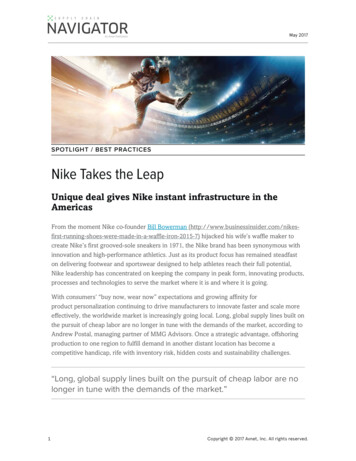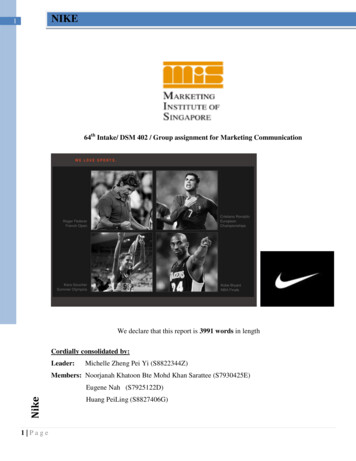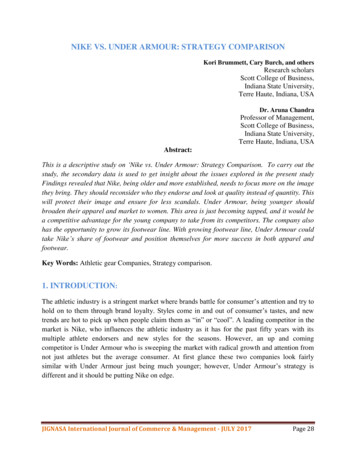
Transcription
NIKE VS. UNDER ARMOUR: STRATEGY COMPARISONKori Brummett, Cary Burch, and othersResearch scholarsScott College of Business,Indiana State University,Terre Haute, Indiana, USADr. Aruna ChandraProfessor of Management,Scott College of Business,Indiana State University,Terre Haute, Indiana, USAAbstract:This is a descriptive study on ‘Nike vs. Under Armour: Strategy Comparison. To carry out thestudy, the secondary data is used to get insight about the issues explored in the present studyFindings revealed that Nike, being older and more established, needs to focus more on the imagethey bring. They should reconsider who they endorse and look at quality instead of quantity. Thiswill protect their image and ensure for less scandals. Under Armour, being younger shouldbroaden their apparel and market to women. This area is just becoming tapped, and it would bea competitive advantage for the young company to take from its competitors. The company alsohas the opportunity to grow its footwear line. With growing footwear line, Under Armour couldtake Nike’s share of footwear and position themselves for more success in both apparel andfootwear.Key Words: Athletic gear Companies, Strategy comparison.1. INTRODUCTION:The athletic industry is a stringent market where brands battle for consumer‟s attention and try tohold on to them through brand loyalty. Styles come in and out of consumer‟s tastes, and newtrends are hot to pick up when people claim them as “in” or “cool”. A leading competitor in themarket is Nike, who influences the athletic industry as it has for the past fifty years with itsmultiple athlete endorsers and new styles for the seasons. However, an up and comingcompetitor is Under Armour who is sweeping the market with radical growth and attention fromnot just athletes but the average consumer. At first glance these two companies look fairlysimilar with Under Armour just being much younger; however, Under Armour‟s strategy isdifferent and it should be putting Nike on edge.JIGNASA International Journal of Commerce & Management - JULY 2017Page 28
2. OBJECTIVES OF THE STUDY:1. To study profile of the select companies2. To analyze the financial performance of the select companies.3. RESEARCH METHODOLOGY:This is a descriptive study on „Nike vs. Under Armour: Strategy Comparison. To carry out thestudy, the secondary data is used to get insight about the issues explored in the present study.4. FINDINGSObjective-1: To study profile of the select companies(A) Industry Analysis:Nike and Under Armour are both in the athletic gear Companies. These companies consists ofsportswear for both men and women, producing many different items such as t-shirts, tanks,sweatshirts, shorts, pants, and shoes. Athletic gear is a growing trend and is popular to wear evenwhen the consumer is not coming to and from the gym. The growth of sales in this industry isexceeding beyond that of the entire apparel market. The reason for the popularity is due to thefact that active wear is now considered “chic.” It is cool to wear yoga pants with a pair of namebrand tennis shoes and even a t-shirt or sweatshirt to match. Men typically wear jeans if they aregoing out or sweatpants or shorts when they are staying in. Even everyday retail stores, likeForever 21 and Maurice‟s, have picked up on the trend and are beginning to sell active wear.Active wear is typically made of a light material, usually spandex for many items. However,spandex is not the only material used. Cotton, polyester, polypropylene, elastane, pique,interlock, jersey, tricot, silver, cooling, and crepe are also common fabrics used to make sportsgear.2 Bright and neon colors are very popular along with fun prints like Aztec or animal.However, this extends past just apparel. There are a variety of different types of athletic shoesincluding running, walking, trail, and even shoes for yoga (a growing athletic trend). Some of themost popular are the running shoes, not because many people like to run, but because of theirlook. Running shoes are usually sleeker and are supported in multiple colors.Although the athletic industry is supported with many different competitors, Nike and UnderArmor are two of the most prominent. Other competitors include Adidas, Puma, Asics, Reebok,and FILA. These are some of the most well-known brands within the athletic industry and theyhold a rather large share of the market. Their ads flood the television screen on sports channelsand also through their hand-picked endorsers with major league sports teams. These endorsersincrease their popularity and this allows them to reach consumers of all ages.The market for the athletic apparel industry is structured as a consolidated industry. Just a fewcompanies control a large enough share of the market to influence its future. ConsolidatedJIGNASA International Journal of Commerce & Management - JULY 2017Page 29
industries usually have high profit margins, well established brands, high barriers to entry, anddistinguished products. Nike has the highly recognized Swoosh logo and Under Armourembodies the dry-fit technology that athletes love on a hot day. Though both companies haveproducts that are made with great quality, their prices are high to appeal to the “inner” crowd andwhat the popular or well-off consumer would wear. This supports their high profit margins.These various attributes make Nike and Under Armour top leaders in the industry.The athletic apparel industry is an international market with multiple competitors. As earlierstated, Nike and Under Armour have a large share in the market. Even so, the market aroundthem influences these two competitors. In 2006 the German company, Adidas, conducted anacquisition of the American company Reebok.10 Key market participants would include AdidasAG, Reebok, Asics American Corporation, FILA Online Inc., Foot Locker Inc., and manyothers.Being the leading company for athletic footwear and apparel, Nike tends to target professionalathletes. However, the fact that they also sell to many retailers allows them to sell to a variety ofconsumers. This includes non-professional athletes, everyday people who want to work out, andthose who just wear the garments for the brand. Even so, Nike creates their value through theirlargest target consumers, professional athletes. Seeing famous athletes wearing the Nike brandadds value and makes more consumers crave their gear. This leads the idea that these brands are“name brand” which to consumers means that they will be more superior if they choose thisbrand over lesser, “cooler” ones like FILA or Reebok.Being very similar to Nike, Under Armour also targets the sportswear market and people whowant to live an active lifestyle. They also market too many people who want to be sporting theUnder Armour look. As previously mentioned, it is becoming very common for people to wearsportswear on a daily basis. Under Armour creates their value by targeting to the youngergeneration. If it catches on with them and they perceive it as “cool,” these products willautomatically start being professed as having a higher value. Like Nike, they will be considered“name brand” and everyone will have to have it.Porter‟s Five Forces is a powerful tool used to understand competition in each industry. In thiscase, it is useful in looking at the competition between Nike and Under Armour. The first ofPorter‟s Five Forces is the rivalry among existing competitors. For the athletic gear market, thiswould include Nike, Puma, Asics, Reebok, FILA, and Under Armour. Each company mustcompete with the quality of their products, as well as other factors including price, speed, andavailability.4Another force is the threat of new entrants, meaning how difficult it is for a new company toenter the market. Also, how costly it would be to enter the industry. An example of this would beUnder Armour. Nike has been a part of the athletic market far longer than Under Armour has.JIGNASA International Journal of Commerce & Management - JULY 2017Page 30
However, Under Armour has been extremely successful within the market; today, they are alarge threat to Nike because of their increasing growth.A third force is the threat of substitutes, which is when businesses from other industries try toenter the athletic wear. There are hundreds of substitutes for Nike and Under Armour‟s athleticwear. These substitutes come from their competitors, but also non-direct competitors. Muchcheaper brands are available for the everyday athlete is not necessarily willing to pay the highprices for athletic wear. An example is Maurice‟s and their more recent line of athletic wear.They will not become as popular as the already existing brands because their focus is solely onathletic gear. However, they have done pretty well with the line.The fourth force in Porter‟s Five Forces is the bargaining power of suppliers. This is howdependent the company is on their suppliers. If the company has only one major supplier thenthat supplier has a lot of power. It is the same for a business having power over the supplier. Forexample, Nike uses private contractors to make their tennis shoes. The workers are paid very lowwages and therefore allow Nike to have all the power.4 However, with ethical issues on laborlaws overseas, Nike may have to reevaluate this strategy.The final force is the bargaining power of the consumer, which is similar to the bargaining powerof suppliers. With this force, the question must be asked, how much does the company dependon their consumers? In the athletic wear and footwear industry, consumers basically have all thepower; it is easy for consumers to switch to another company if they so desire. Customers canchange manufacturers for any reason whether it is price, convenience, quality, or even a newstyle.4 some consumers even buy products from multiple companies within the industry.(B) Level Analysis:No one can argue that Nike is a powerhouse in the athletic footwear and apparel industry.Originally founded in 1964 as Blue Ribbon Sports, the company officially changed their name toNike, Inc. in 1971.11 since that time; Nike has expanded their line and their global reach togenerate more than 30 Billion in sales for the 2015 fiscal year.The early success of Blue Ribbon Sports was due to sales of a reasonably priced running shoe.Since that time, Nike has achieved success by offering athletic footwear, and eventually appareland accessories, for a wide range of sports. According to the letter to the shareholders fromNike‟s 2015 annual report, Mark Parker, President and CEO, states the “breadth and depth of ourpowerful portfolio across brands, categories, geographies, gender and channel is unmatched.And we remain well-resourced and well-positioned to create competitive separation and deliversustainable and profitable growth by continuing to leverage that portfolio”.5 It is interesting tonote that maintaining a competitive edge is still important to Mr. Parker even though Nike is theuncontested leader in the athletic footwear and apparel industry.JIGNASA International Journal of Commerce & Management - JULY 2017Page 31
There are many strong competitors that exist in the industry, Adidas and Sketchers just to name afew. A strong competitor to watch is Under Armour. Under Armour was founded in 1996 andhas shown significant growth since that time. In less than 20 years, Under Armour‟s annual salesrecently reached 3 Billion. This is small by comparison; just 10% of the total sales for Nikehowever, Under Armour‟s growth rate is increasing and they are becoming an increasing threatto Nike.5In order to better understand Nike and Under Armour, a tool developed by Don Hambrick andJim Fredrickson called the strategy diamond will be used to outline some core strengths and keystrategies for each company.1 The strategy diamond first examines the arenas in which thecompany‟s function. Nike has identified six geographic regions which are broken into twocategories: developed and developing. The developed markets for Nike are North America,Western Europe and Japan. The developing markets are Greater China, Central & EasternEurope, and Emerging Markets.3 Nike has physical stores in these regions while also selling theirproducts online and through local retailers. Under Armour have also increased internationalsales, primarily by focusing on e-commerce sites and local distributors in three target regions:The United Kingdom, Germany, and France. Sales distributors in Mexico, Brazil and Chile arealso gaining brand recognition for Under Armour.9Differentiation is another component of the strategy diamond and focuses on the corecompetencies that make a firm unique and successful. While Nike and Under Armour are bothin the athletic footwear and apparel industry, there are significant differences between eachcompany. Nike‟s core strength has traditionally been athletic footwear, for professional andamateur athletes as well as the casual consumer. In the first quarter of 2015, Nike shoesaccounted for approximately 62% of sales of all athletic shoes. Sketchers came in a distantsecond place with only 5%.7 Nike‟s success is due to a long history of producing high qualityathletic shoes for a variety of sports, and to a strategy that Nike refers to as Category Offense.3Categories are divided into action sports, athletic training, basketball, football, running,sportswear, and women‟s training. The goal of this consumer-focused category strategy is to“drive growth through increased market place capacity and penetration”.3While Nike is the clear leader in footwear sales, nearly 74% of Under Armour sales are fromapparel.9 In 1996, a former college football player named Kevin Plank started Under Armourwith the mission to create apparel that could keep athletes cool and dry in hot game dayconditions. Under Armour has gone on to engineer a variety of fabrics such as HeatGear,ColdGear, and AllSeasonGear which have applications in a large variety of sports
Being very similar to Nike, Under Armour also targets the sportswear mar ket and people who want to live an active lifestyle. They also market too many people who want to be sporting the Under Armour look. As previously mentioned, it is becoming very common for people to wear sportswear on a daily basis. Under Armour creates th eir value by targeting to the younger

